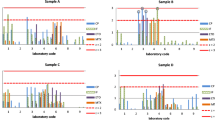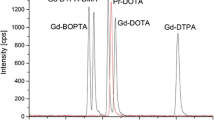Abstract
A high-performance liquid chromatography–inductively coupled plasma mass spectrometry (HPLC–ICP–MS) method is presented for analysis of cisplatin, monoaquacisplatin, diaquacisplatin, carboplatin, and oxaliplatin in biological and environmental samples. Chromatographic separation was achieved on pentafluorophenylpropyl-functionalized silica gel. For cisplatin, carboplatin, and oxaliplatin limits of detection of 0.09, 0.10, and 0.15 μg L−1, respectively, were calculated at m/z 194, using aqueous standard solutions. (3 μL injection volume). The method was utilized for model experiments studying the stability of carboplatin and oxaliplatin at different chloride concentrations simulating wastewater and surface water conditions. It was found that a high fraction of carboplatin is stable in ultrapure water and in solutions containing 1.5 mol L−1 Cl−, whereas oxaliplatin degradation was increased by increasing the chloride concentration. In order to support the assessment of oxaliplatin eco-toxicology, the method was tested for speciation of patient urine. The urine sample contained more than 17 different reaction products, which demonstrates the extensive biotransformation of the compound. In a second step of the study the method was successfully evaluated for monitoring cancerostatic platinum compounds in hospital waste water.




Similar content being viewed by others
References
Roberts JJ, Thomson AJ (1979) Prog Nucleic Acid Res Mol Biol 22:71
Pineto HM, Schornagel JH (eds) (1996) Platinum and other metal coordination compounds in cancer chemotherapy 2. Plenum, New York
Desoize B and Madoulet C (2002) Crit Rev Oncol Hematol 42:317–325
Allwood M, Stanley A, Wright P (eds) (1997) The cytotoxics handbook. Radcliffe Medical Press, Abingdon
Dorr RT, Von Hoff DD (1994) Cancer chemotherapy book. McGraw–Hill, Columbus
Graham MA, Gamelin E, Misset JL, Brienza S, Allain P, Boisdron-Celle, Krikorian A, Greenslade D, Bayssas M (1998) Proc Am Assoc Cancer Res 39:159
Mahnik S, Mader R, Fürhacker M (2002) ÖWAV Workshop: Arzneimittel in der aquatischen Umwelt, 26.9.2002, Universität für Bodenkultur Wien; Zytostatika im Abwasser. Wiener Mitteilungen 178:91–111
International Agency for Research on Cancer (IARC), (1987) Monographs on the Evaluation of Cancerogenic Risks to Humans, suppl 7, Lyon
Gebel T (2000) AAAa. In: Zereini F, Alt F (eds) Anthropogenic platinum group element emissions. Springer Verlag, Berlin Heidelberg New York, pp 245–255
Heudi O, Cailleux A, Allain P (1998) J Inorg Biochem 71:61–69
Pujol M, Girona V, Prat J, Munoz M, De Bolos J (1997) Int J Pharm 146:263–269
Schnurr B, Gust R (2002) Microchim Acta 140:69–76
Jerremalm E, Videhult P, Alvelius G, Griffiths WJ, Bergman T, Eksborg S, Ehrsson H (2002) J Pharm Sci 91:2116–2121
El-Khateeb M, Appleton TG, Gahan LR, Charles BG, Berners-Price SJ, Bolton A (1999) J Inorg Biochem 77:13–21
Zhao Z, Tepperman K, Dorsey JG, Elder RC (1993) J Chromatogr 615:83–89
Cairns WRL, Ebdon L, Hill SJ (1996) Fresenius J Anal Chem 355:202
Hann S, Zenker A, Galanski M, Bereuter TL, Stingeder G, Keppler BK (2001) Fresenius J Anal Chem 370:581–586
Vacchina V, Torti L, Allievi C, Lobinski R (2003) J Anal At Spectrom 18:884–890
Luo FR, Yen T-Y, Wyrick SD, Chaney SG (1999) J Chromatogr B 724:345–356
Burns RB, Burton RW, Albon SP, Embree L (1996) J Pharm Biomed Anal 14:367–372
Küng A, Strickmann DB, Galanski M, Keppler BK (2001) J Inorg Biochem 86:691–698
Lederer M, Leipzig-Pagani E (1998) Int J Pharm 167:223–228
Ehrsson H, Wallin I (2003) J Chromatogr B 795:291–294
Zenker A, Galanski M, Bereuter TL, Keppler BK, Lindner W (2000) J Chromatogr B 745:211–219
De Waal WAJ, Maessen FJMJ, Kraak JC (1987) J Chromatogr 407:253–272
Lenz K, Hann S, Koellensperger G, Stefanka Zs, Stingeder G, Weissenbacher N, Mahnik SN, Fuerhacker M, J Environ Monit (submitted)
Falter R, Wilken RD (1999) Sci Total Environ 225:167–176
Hann S, Koellensperger G, Stefánka Zs, Stingeder G, Fürhacker M, Buchberger W, Mader RM (2003) J Anal At Spectrom 18:1391–1395
Stefánka Zs, Hann S, Koellensperger G, Stingeder G (2004) J Anal At Spectrom. DOI:10.1039/B402028F
Kiffmeyer T, Götze HJ, Jursch M, Lüders U (1998) Fresenius J Anal Chem 361:185–191
Quantifying Uncertainty in Analytical Measurement (2000) EURACHEM, London
Davies MS, Berners-Price SJ, Hambley TW (2000) Inorg Chem 39:5603–5613
Hindmarsch K, House DA, Turnbull MM (1997) Inorg Chim Acta 39:11–18
Gust R, Schnurr B (1999) Chem Monthly 130:637–644
Tang X, Hayes II JW, Schroder L, Cacini W, Dorsey J, Elder RC, Tepperman K (1997) Met Based Drugs 4:97–109
Jerremalm E, Hedeland M, Wallin I, Bondesson U, Ehrsson H (2004) Pharm Res 21:891–894
Graham MA, Lockwood GF, Greenslade D, Brienza S, Bayssas M, Gamelin E (2000) Clin Cancer Res 6:1205–1218
Acknowledgements
Financial support was granted through the Austrian Science Fund (FWF-Project P16089-N03: “Speciation of cancerostatic Pt compounds in the environment”). Professor Robert Mader (Vienna University Hospital) is gratefully acknowledged for sampling of patient urine.
Author information
Authors and Affiliations
Corresponding author
Rights and permissions
About this article
Cite this article
Hann, S., Stefánka, Z., Lenz, K. et al. Novel separation method for highly sensitive speciation of cancerostatic platinum compounds by HPLC–ICP–MS. Anal Bioanal Chem 381, 405–412 (2005). https://doi.org/10.1007/s00216-004-2839-z
Received:
Revised:
Accepted:
Published:
Issue Date:
DOI: https://doi.org/10.1007/s00216-004-2839-z




